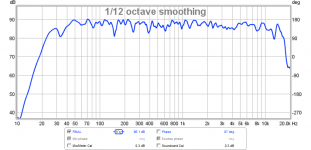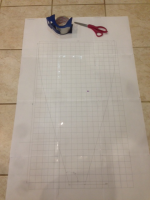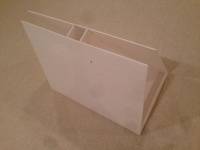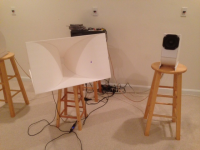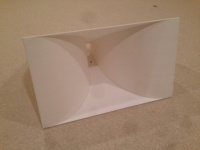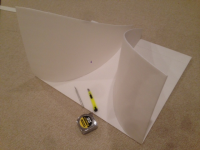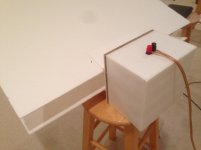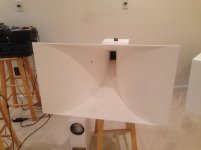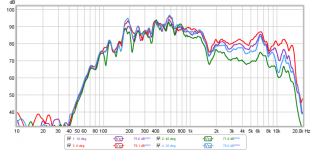Playing with EQ in miniDSP
At the suggestion of a member on the multiway forum, I EQ'd flat the cone breakup peaks at 5kHz, 7kHz, and 9kHz (between -3dB and -5dB applied). As they seem to be pretty constant with directivity, it seemed to be a good thing to do. Also, the peaks are in the range above the critical 500Hz to 5kHz vocal range where all the phase and spatial coherence are important so I did not think the EQ would detract from the single point source impact. Here is a sound clip of the new EQ'd system. I think it sounds smoother and the transients appear more defined.
Here is the new measured freq response from listening position:
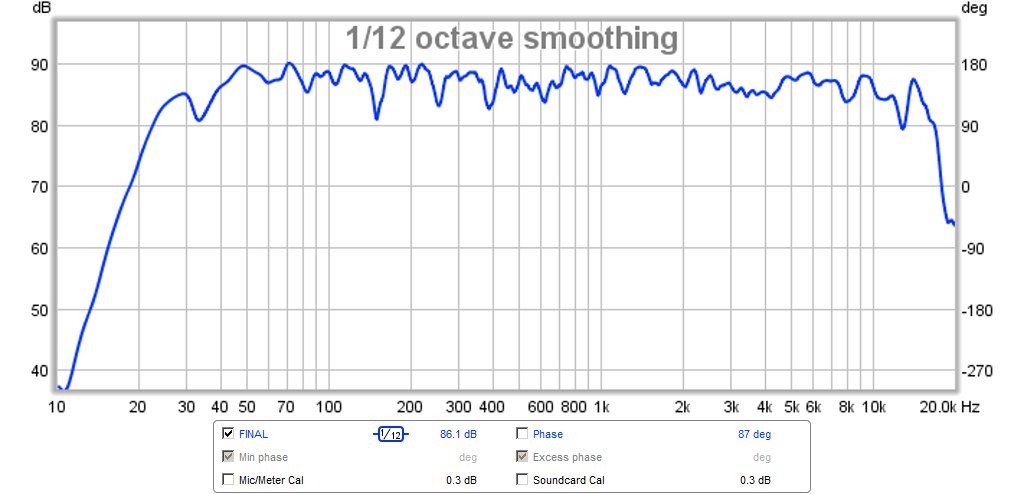
Let me know what you think...
At the suggestion of a member on the multiway forum, I EQ'd flat the cone breakup peaks at 5kHz, 7kHz, and 9kHz (between -3dB and -5dB applied). As they seem to be pretty constant with directivity, it seemed to be a good thing to do. Also, the peaks are in the range above the critical 500Hz to 5kHz vocal range where all the phase and spatial coherence are important so I did not think the EQ would detract from the single point source impact. Here is a sound clip of the new EQ'd system. I think it sounds smoother and the transients appear more defined.
Here is the new measured freq response from listening position:

Let me know what you think...
Attachments
Last edited:
"Many folks will be perfectly happy with 15kHz highs"
I can't hear a lick above 15hz anyway.
You must have the hearing of a blue whale as you can't hear anything above 15Hz infra bass. 🙂
Sounds nice from my synergy horns! Your setup and eq seems quite neutral.
We need a sound clip of your synergy horn. Use your measurement mic and a recorder program. Can't wait to hear it. Even mono would be cool.
I think this sounds really good and lets you hear the different textures, fluid vocals, soundstage, and percussive impact.
What mic do you use for recording, and from where are the recordings made (from listening position?) ? They sound nice. Have you posted you listening room's RT60/echo etc. data somewhere?
I'll see what I can do today recording some (perhaps mocking) sounds from my system 🙂.
Last edited:
What mic do you use for recording, and from where are the recordings made (from listening position?) ? They sound nice. Have you posted you listening room's RT60/echo etc. data somewhere?
I'll see what I can do today recording some (perhaps mocking) sounds from my system 🙂.
This is from listening position near middle back of room about 2.5m away. Speakers are about 2 m apart and 1m from back wall. I use a Zoom H4 digital recorder and built in XY mic. I record to 24bit at 96kHz wav file. Then convert to mp3 in Audacity. You can also record straight to mp3 from recorder. I find this gives best sound quality and lets me adjust compression and length to fit clip into the 964k limit for uploads on diyAudio.
http://en.m.wikipedia.org/wiki/Zoom_H4_Handy_Recorder
My room has a lot of reverberation as there are no treatments. Just hard drywall and carpet on concrete floor. Does REW measure RT60 ?
I definitely hear the echo when I listen to the recording vs the source material without speaker. But it actually sounds better with speakers in the room than good monitor headphones. You cannot recreate the bass impact and the spatial imaging with headphones.
Last edited:
This is from listening position near middle back of room about 2.5m away. Speakers are about 2 m apart and 1m from back wall. I use a Zoom H4 digital recorder and built in XY mic. I record to 24bit at 96kHz wav file. Then convert to mp3 in Audacity. You can also record straight to mp3 from recorder. I find this gives best sound quality and lets me adjust compression and length to fit clip into the 964k limit for uploads on diyAudio.
Zoom H4 Handy Recorder - Wikipedia, the free encyclopedia
My room has a lot of reverberation as there are no treatments. Just hard drywall and carpet on concrete floor. Does REW measure RT60 ?
I definitely hear the echo when I listen to the recording vs the source material without speaker. But it actually sounds better with speakers in the room than good monitor headphones. You cannot recreate the bass impact and the spatial imaging with headphones.
Yes REW can show you RT60 among other things.
I tested making a recording also. Sounds uninspiring when listened from my headphones, like a 2 dollar car radio, undynamic and lifeless. I had to use ~25dB of digital gain in Audacity to get the sound level up (even though I played the song with 90db(C) peaks), it added hiss to the recording. Your samples sound much nicer. Here it is anyway.
Here's the freq response at the exact spot where the mic was on my couch.
An externally hosted image should be here but it was not working when we last tested it.
Attachments
Last edited:
Yes REW can show you RT60 among other things.
I tested making a recording also. Sounds uninspiring when listened from my headphones, like a 2 dollar car radio, undynamic and lifeless. I had to use ~25dB of digital gain in Audacity to get the sound level up (even though I played the song with 90db(C) peaks), it added hiss to the recording. Your samples sound much nicer. Here it is anyway.
Here's the freq response at the exact spot where the mic was on my couch.
An externally hosted image should be here but it was not working when we last tested it.
Legis,
Thanks! I know it can be tough for a recording to do justice to the real thing. I have same thoughts when I hear the recorded version vs real life listening. Your recording does help to convey the bass impact of your PPTP though. I can only imagine the real life pressure on your body with the kick drums. So you also get a sense of what the Nautaloss and my bass horn sub sounds like in real life vs headphones: about 10x better 🙂 It makes a difference to have an XY mic recorder though as that conveys the stereo and room spatialization very well. I appreciate your effort to share the sound impression. Many folks will not go through the trouble to do this. I can count people who do on diyAudio on one hand - and you and I are two of the fingers.
If I were to get another recorder - this would be at top of my list. Much more compact now and has protective screen for mics.
http://www.amazon.com/gp/aw/d/B005CQ2ZY6/ref=mp_s_a_1_1?qid=1408278068&sr=8-1&pi=SY200_QL40
Last edited:
Another try... I like the sound filed and echo rendering of my Galaxy S4 better than the previous measurement mic record.
https://www.youtube.com/watch?v=lwz1hUB__XU
https://www.youtube.com/watch?v=lwz1hUB__XU
Another try... I like the sound filed and echo rendering of my Galaxy S4 better than the previous measurement mic record.
https://www.youtube.com/watch?v=lwz1hUB__XU
That sounded very nice - it was neat to see a video of your system - very different than seeing a photo. I agree the ambience of the Galaxy S4 is better - it must have stereo mics? I see you like the September in Montreal for a demo track 🙂 That is an amazing song for testing speakers. It has content down to 25Hz I think and you can feel that with a TH.
Hello, I have been viewing this thread with interest. This looks like a very good driver - all the goodness of a little PC speaker, but with pro audio ruggedness and output.
I notice the polar plots and nautiloss graphs you give line up very well with the manufacturer FR plot.
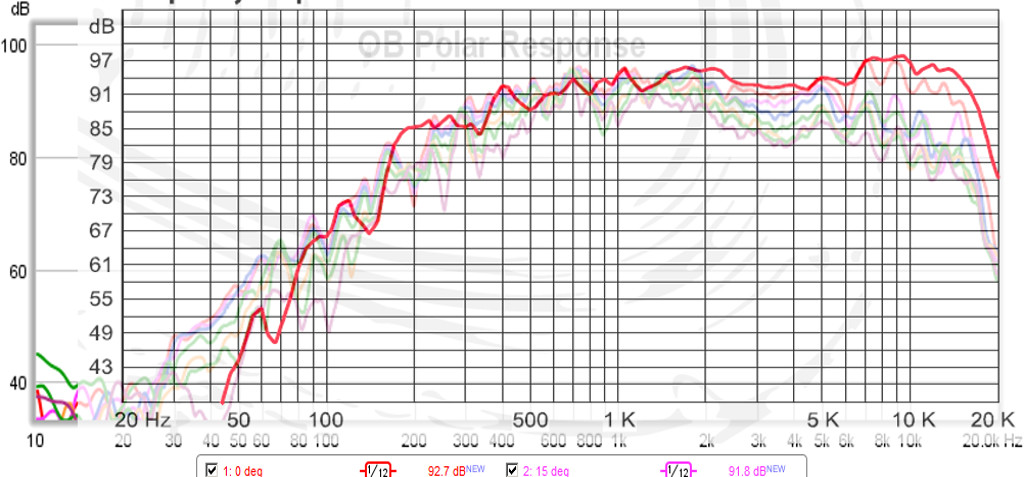
Other of your measurements do not, such as in your first post - the low end seems oddly robust.
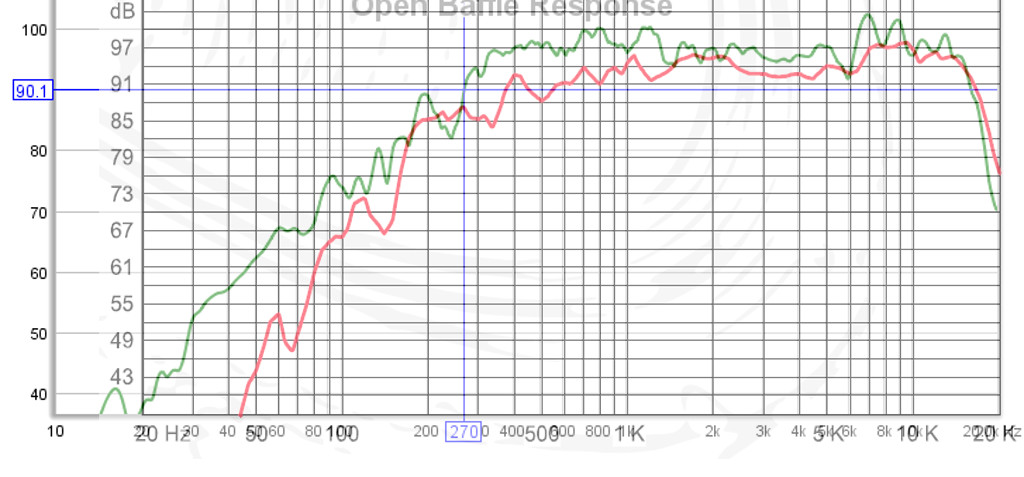
Is there something inconsistent about how you are taking measurements (mic positions, background noise, baffle sizes, baffle rigidity)?
Assuming that the first graphs I've referenced here (your polar and nautiloss plots, as well as the manufacturer's data) are more accurate, then the driver is at it's advertised sensitivity from 1-15kHz, but has dropped by 9dB when it gets down to 300Hz. That is, the manufacturer's data (and some of yours) shows that is rolls off fairly evenly down to ~85dB by 300Hz.
Again, assuming this is correct, if I were to horn load this PRV driver, I would not aim for >95dB sensitivity. I'd try to boost its low end to 95dB, to match the upper mids. I'd use a short, wide, simple horn (no throat compression, no phase plug), similar to existing Oris / Azura systems. These are essentially a fancy way of corner loading the driver (I don't mean this disparagingly: corner placement / 8th space gives +9dB low end gain, which is exactly what the manufacturer's data indicates the driver needs).
I notice the polar plots and nautiloss graphs you give line up very well with the manufacturer FR plot.

Other of your measurements do not, such as in your first post - the low end seems oddly robust.

Is there something inconsistent about how you are taking measurements (mic positions, background noise, baffle sizes, baffle rigidity)?
Assuming that the first graphs I've referenced here (your polar and nautiloss plots, as well as the manufacturer's data) are more accurate, then the driver is at it's advertised sensitivity from 1-15kHz, but has dropped by 9dB when it gets down to 300Hz. That is, the manufacturer's data (and some of yours) shows that is rolls off fairly evenly down to ~85dB by 300Hz.
Again, assuming this is correct, if I were to horn load this PRV driver, I would not aim for >95dB sensitivity. I'd try to boost its low end to 95dB, to match the upper mids. I'd use a short, wide, simple horn (no throat compression, no phase plug), similar to existing Oris / Azura systems. These are essentially a fancy way of corner loading the driver (I don't mean this disparagingly: corner placement / 8th space gives +9dB low end gain, which is exactly what the manufacturer's data indicates the driver needs).
Hollowboy,
Thanks for superimposing the graphs! The first plot which appears to have more robust bass is due to fact that it was mounted on a 12 inch wide open baffle and is a little closer to the ground. The Nautaloss is a 5in wide baffle and has no back wave like the OB. They are not measured at same positions. There was no EQ going on in either though son it is all room placement and baffle size effects I think. I am working on putting it in a front horn as I have described. Hopefully it will have 300 Hz to 15kHz.
Thanks for superimposing the graphs! The first plot which appears to have more robust bass is due to fact that it was mounted on a 12 inch wide open baffle and is a little closer to the ground. The Nautaloss is a 5in wide baffle and has no back wave like the OB. They are not measured at same positions. There was no EQ going on in either though son it is all room placement and baffle size effects I think. I am working on putting it in a front horn as I have described. Hopefully it will have 300 Hz to 15kHz.
Tractrix horn build begins
To start things off, the 2d flat pattern for the 3d curved panel was generated using sheet metal un-roll function in SW. Then it was printed at full-scale using the Acrobat print to tile function. I then taped up the sheets to make the pattern shown. Next step will be to transfer the pattern to foam core using the punch many little holes through the pattern with a ballpoint pen.
To start things off, the 2d flat pattern for the 3d curved panel was generated using sheet metal un-roll function in SW. Then it was printed at full-scale using the Acrobat print to tile function. I then taped up the sheets to make the pattern shown. Next step will be to transfer the pattern to foam core using the punch many little holes through the pattern with a ballpoint pen.
Attachments
Tractrix horn build #2
Here is the almost completed tractrix horn made out of foam core. It measures 28 in wide x 17 in tall x 22 in deep. Once an accurate CAD-generated pattern is cut, the assembly went very quickly as it self-forms into the right shape once the throat and mouth edges are anchored. I still need to add the driver mounting flange, some bracing, and a rear chamber. It is larger than one would think once you hold it in your hands (see photo next to Nautaloss and stools for scale). Luckily it doesn't weigh anything. I held it up against the driver with my head in front of the mouth and it really amplifies the sound with no seal on the driver. Sounds good to my ears so far...
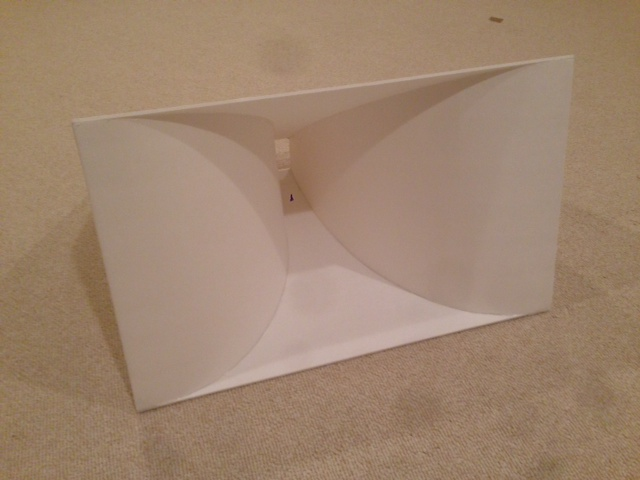
Here is the almost completed tractrix horn made out of foam core. It measures 28 in wide x 17 in tall x 22 in deep. Once an accurate CAD-generated pattern is cut, the assembly went very quickly as it self-forms into the right shape once the throat and mouth edges are anchored. I still need to add the driver mounting flange, some bracing, and a rear chamber. It is larger than one would think once you hold it in your hands (see photo next to Nautaloss and stools for scale). Luckily it doesn't weigh anything. I held it up against the driver with my head in front of the mouth and it really amplifies the sound with no seal on the driver. Sounds good to my ears so far...

Attachments
Last edited:
First Sound with Tractrix
I made a 5.25 liter rear chamber lined it with grey foam, added binding posts and quick disconnects. The driver mounts to the horn flange then the box covers the back of the driver and is screwed on tight.
Initial listening tests indicate that the panels vibrate a lot so I will have to add bracing later. However, the naysayers who said nothing more than 5kHz will get through, and they also said the polar directivity won't have anything off axis to speak of, they are, fortunately, all wrong. The tractrix as designed indeed lets HF's through and works off-axis. I get 15kHz on axis and it drops off with angle but clearly this is substantial HF getting out of the horn. Some rough polars (+/- 3 deg) show that the directivity is not bad. Up to +/- 30 deg is very respectable. I did not have time to remove the baffle step shelf EQ from the Nautaloss so this is certainly not optimized. I need to give it a rising response so that it will be flat, but this driver has lots of headroom so that should not be a problem. The 1.7kHz dip corresponds to 4in - probably the rear chamber reflection. Ideally a Nautaloss back chamber would be ideal.
I made a 5.25 liter rear chamber lined it with grey foam, added binding posts and quick disconnects. The driver mounts to the horn flange then the box covers the back of the driver and is screwed on tight.
Initial listening tests indicate that the panels vibrate a lot so I will have to add bracing later. However, the naysayers who said nothing more than 5kHz will get through, and they also said the polar directivity won't have anything off axis to speak of, they are, fortunately, all wrong. The tractrix as designed indeed lets HF's through and works off-axis. I get 15kHz on axis and it drops off with angle but clearly this is substantial HF getting out of the horn. Some rough polars (+/- 3 deg) show that the directivity is not bad. Up to +/- 30 deg is very respectable. I did not have time to remove the baffle step shelf EQ from the Nautaloss so this is certainly not optimized. I need to give it a rising response so that it will be flat, but this driver has lots of headroom so that should not be a problem. The 1.7kHz dip corresponds to 4in - probably the rear chamber reflection. Ideally a Nautaloss back chamber would be ideal.
Attachments
Last edited:
 ...Go on very good work and thanks sharing.
...Go on very good work and thanks sharing.Probably the baffle step shelf EQ not neutralized but looks like you got it nearly down to 100Hz if "EQing the 150Hz-1500Hz area down by 10dB", then in a home system it could be 2 way instead of 3 way. Though you written earlier that the 3 way'er is meant for very high SPL sytem and not for home use.
Thanks for kind words Byrtt. As soon as if have time to redo EQ we will see how this can work. I will probably add constrained layer damping on panels.
Awesome.
Now the fundamental is done, the following reinforcement will be relatively easy. Probably more time consuming, though.
HF is affected by the throat size and its relationship with Sd.
Have you read this? Phase Plugs
Now the fundamental is done, the following reinforcement will be relatively easy. Probably more time consuming, though.
HF is affected by the throat size and its relationship with Sd.
Have you read this? Phase Plugs
- Home
- Loudspeakers
- Full Range
- PRV 5MR450-NDY for FAST/WAW applications
